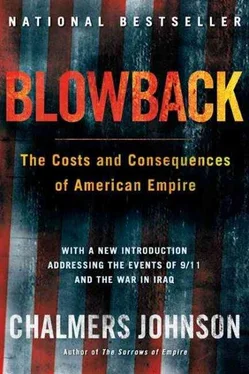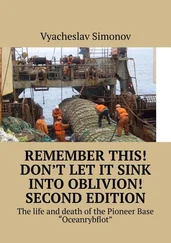Chalmers Johnson - Blowback, Second Edition - The Costs and Consequences of American Empire
Здесь есть возможность читать онлайн «Chalmers Johnson - Blowback, Second Edition - The Costs and Consequences of American Empire» весь текст электронной книги совершенно бесплатно (целиком полную версию без сокращений). В некоторых случаях можно слушать аудио, скачать через торрент в формате fb2 и присутствует краткое содержание. Год выпуска: 0101, ISBN: 0101, Издательство: Macmillan, Жанр: Старинная литература, на английском языке. Описание произведения, (предисловие) а так же отзывы посетителей доступны на портале библиотеки ЛибКат.
- Название:Blowback, Second Edition: The Costs and Consequences of American Empire
- Автор:
- Издательство:Macmillan
- Жанр:
- Год:0101
- ISBN:9780805075595
- Рейтинг книги:5 / 5. Голосов: 1
-
Избранное:Добавить в избранное
- Отзывы:
-
Ваша оценка:
- 100
- 1
- 2
- 3
- 4
- 5
Blowback, Second Edition: The Costs and Consequences of American Empire: краткое содержание, описание и аннотация
Предлагаем к чтению аннотацию, описание, краткое содержание или предисловие (зависит от того, что написал сам автор книги «Blowback, Second Edition: The Costs and Consequences of American Empire»). Если вы не нашли необходимую информацию о книге — напишите в комментариях, мы постараемся отыскать её.
Blowback, Second Edition: The Costs and Consequences of American Empire — читать онлайн бесплатно полную книгу (весь текст) целиком
Ниже представлен текст книги, разбитый по страницам. Система сохранения места последней прочитанной страницы, позволяет с удобством читать онлайн бесплатно книгу «Blowback, Second Edition: The Costs and Consequences of American Empire», без необходимости каждый раз заново искать на чём Вы остановились. Поставьте закладку, и сможете в любой момент перейти на страницу, на которой закончили чтение.
Интервал:
Закладка:
The American government’s attempt to promote the TMD in this context is an unwelcome provocation. Its untested technology will not, in the end, reassure the Taiwanese, while the Chinese fear it as the basis for a strengthened military alliance between Taiwan and the United States. Wang Daohan, a senior adviser to President Jiang Zemin, said to the press of a possible future deployment of the TMD in Taiwan, “It is like playing with fire. That will completely disrupt the current world situation, and instead a new Cold War will appear.” 4
None of this is even slightly necessary. The United States needs to bring its own security apparatus under control and stop exaggerating the Chinese military threat. With regard to nuclear warheads, for example, between 1964, when China first tested a nuclear device, and 1996, when China signed the Comprehensive Test-Ban Treaty, it conducted 45 nuclear tests. The United States, in contrast, has conducted 1,030 nuclear tests, not including the actual atomic bombings of Hiroshima and Nagasaki. Robert Walpole, the CIA’s national intelligence officer for strategic and nuclear programs, testified in September 1998 that China had at most twenty ICBMs, which were being maintained in an unfueled state and with their warheads unattached. 5Admiral Dennis C. Blair, commander in chief in the Pacific, testified before Congress in March 1999 that “China is not a military threat to U.S. interests. It will be many years before the People’s Liberation Army presents a major challenge to U.S. forces.” 6And yet, in that same month, the Senate voted 97-3 to build a “national missile defense” essentially against China and North Korea, and President Clinton endorsed spending some $10.6 billion on it over the coming five years. This is American overstretch, not a responsible national defense policy.
Some members of Congress and Pentagon officials are also promoting worst-case scenarios about Chinese moves in the South China Sea. Through this waterway passes virtually all of the oil from the Middle East intended for China, Japan, South Korea, and Taiwan. There are two sets of about a thousand islands, reefs, and rocks in the South China Sea, the Spratlys (Nansha in Chinese) and the Paracels (Xisha), which are claimed in part or in whole by seven different governments—those of China, Vietnam, Taiwan, the Philippines, Malaysia, Brunei, and Indonesia. It was only in late 1987 that sovereignty over the Spratlys first became an issue in Chinese foreign policy, reflecting a shift to nationalism as the main legitimating principle of the regime. Most of these barren bits of land are unoccupied, but during the late 1980s and early 1990s, in pursuit of their various claims, China occupied six of them, Vietnam twenty-one, the Philippines six, Malaysia three, and Taiwan one. 7
In March 1988, China first occupied its six locations; later that same year it separated its large southern island, Hainan, from Guangdong Province, making it a special economic zone and a major military base. In February 1992, it passed the “Law of the People’s Republic of China on the Territorial Sea and the Contiguous Zone,” which laid down an exclusive claim to the entire Spratly archipelago, about 340,000 square miles of ocean, and authorized the Chinese navy to evict “trespassers” by force. In February 1995, China built a structure on a rocky formation claimed by the Philippines about 135 miles west of that country and hundreds of miles from the Chinese mainland. At that time the aptly named Mischief Reef was unoccupied. Although China has been verbally belligerent on the issue of the Spratlys, it has also been careful not to seize a rock or reef already occupied by some other nation.
China and Vietnam have already clashed twice in the South China Sea, once in 1974 over the Paracels and again in a short but bloody naval battle over the Spratlys in 1988. China has staked its claim to the islands on a series of fifteenth-century voyages by Ming dynasty admiral Cheng Ho. According to Vietnam, China was even then infringing on its territory. Meanwhile, Malaysia is building a tourist resort on its island, known as Terumbu Layang-Layang. All the nations of the area have increased their defense postures significantly.
China’s island policies certainly reflect the force of its new nationalism and its commitment to defend all claims to Chinese territory as a way of dramatizing its previous humiliations at the hands of imperialist powers. It is a policy that may also reflect incipient Chinese hege-monism, a response to the breakup of the USSR and to the American claims of being the “indispensable nation” in East Asia. And there may be oil under the Spratlys. China is now a net oil importer, reflecting its advancing industrialization and motorization, so it is interested in any potential new source of oil. Many experts doubt, however, that any significant reserves in the South China Sea will ever materialize, as the waters separating the Spratlys are about 2,000 meters deep. The deepest oceanic drilling for oil at present is only to a depth of 872 meters in the Gulf of Mexico.
It is more than likely that the issues surrounding the South China Sea will be contained by ongoing negotiations between China and ASEAN, focusing not on sovereignty but on “confidence-building measures.” China has actually moderated its claims to the area over time. To date, this dispute is a classic example of the dangers of worst-case analysis—that is, of treating possibilities as probabilities or inevitabilities, particularly when doing so, in the American case, may someday contribute to a larger military budget.
Tibet is another matter. As an independent state or even culture, it is probably doomed. China is currently implementing what the Dalai Lama calls its “final solution” for Tibet—an openly racist policy of state-sponsored Chinese emigration to the area and forced “assimilation” (the word used in the Chinese press is hanhua , literally “to make Chinese”) of what is left of the Tibetan people. Tibet’s only hope lies in the extraordinary efforts of the Dalai Lama, Tibet’s priest-king, and his followers in exile in Dharamsala, India, to internationalize their struggle. Combined with continuing Chinese blunders, it is possible (though not likely) that global concern will raise the costs to China of its obstinate and destructive behavior. Meanwhile, Sinophiles at many foreign academic institutions and ministries of foreign affairs continue to advise their political leaders that Tibet has always been a part of China, which is simply not so.
The concept of irredentism does not apply to Tibet. It was never a province of China, nor was it even involved in the normal tributary relationships that vassal states of Imperial China traditionally maintained with Beijing. The Tibetans are of Mongol origin; their country emerged as a distinct place in the seventh century, when an early version of Mahayana Buddhism took root there. China first established relations with Tibet during the Tang dynasty (618-906). In the twelfth and thirteenth centuries, Tibet was heavily influenced by Indian Buddhists fleeing ahead of the Muslim invasion of the subcontinent. During the thirteenth century Mongol power came to predominate in Lhasa, just as the Mongols also ruled at that time in Beijing, but Mongol influence persisted in Tibet until the eighteenth century, much longer than in China itself. In 1270, Kublai Khan was converted to Lamaism by the abbot of the Sakya lamasery.
In 1720 the Manchu dynasty in China replaced Mongol rule in Tibet, and from that time on China claimed a limited suzerainty over Tibet—actually a loose arrangement in which Beijing was responsible for foreign relations and defense while Lhasa was left entirely in charge of domestic affairs. After imperial rule collapsed in 1912, Tibet became something like an independent state with its own governing institutions and even a small army, although its nationhood was not recognized by any other country. During this period the Tibetans expelled most Chinese. All this changed with the Chinese Communist invasion in 1950.
Читать дальшеИнтервал:
Закладка:
Похожие книги на «Blowback, Second Edition: The Costs and Consequences of American Empire»
Представляем Вашему вниманию похожие книги на «Blowback, Second Edition: The Costs and Consequences of American Empire» списком для выбора. Мы отобрали схожую по названию и смыслу литературу в надежде предоставить читателям больше вариантов отыскать новые, интересные, ещё непрочитанные произведения.
Обсуждение, отзывы о книге «Blowback, Second Edition: The Costs and Consequences of American Empire» и просто собственные мнения читателей. Оставьте ваши комментарии, напишите, что Вы думаете о произведении, его смысле или главных героях. Укажите что конкретно понравилось, а что нет, и почему Вы так считаете.










